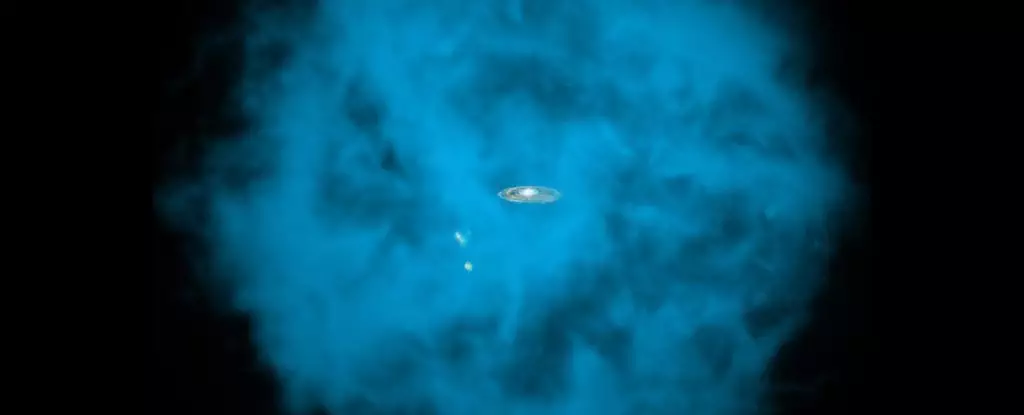Beneath the vast multitude of stars and galaxies lies an enigma that has baffled astronomers for decades—the missing baryonic matter of the universe. Recent revelations have made significant headway into uncovering the whereabouts of this elusive matter, confirming that a substantial part of it exists beyond the active cores of galaxies. Rather than being omnipresent and easily detectable, the missing matter cloaks itself as vast, invisible clouds of ionized hydrogen scattered throughout intergalactic spaces. The ingenuity of an international coalition of scientists has led to innovative techniques that illuminate this hidden reservoir, allowing us to see, albeit faintly, the constituents that form the backbone of our cosmic existence.
This surge in understanding follows a meticulous convergence of observation and theory. Central to this exploration is the realization that hydrogen, primarily found in its ionized state, constitutes more than 50% of the universe’s total mass. Despite its abundance, the challenge of detecting this hydrogen has been daunting; its faint presence obscured by the unfathomable distances that stretch between galaxies. Through innovative observational methods, a team of astrophysicists has made critical discoveries that incrementally piece together this cosmic puzzle—setting the stage for profound paradigm shifts in our comprehension of the universe.
Utilizing Cosmic Backgrounds
The key to unveiling the mystery surrounding these clouds of hydrogen lies in the exploration of the Cosmic Microwave Background (CMB)—the afterglow of the Big Bang that now permeates the cosmos. By harnessing the effects of the CMB on distant light sources, scientists have devised a way to map the diffuse gas that eluded detection for so long. As light traverses through intergalactic hydrogen, it experiences subtle shifts in brightness and color, a phenomenon known as the kinematic Sunyaev-Zel’dovich effect. This transformative approach reveals the previously obscured presence of hydrogen clouds, transforming a flickering whisper in the void into a full-bodied chorus that enriches our understanding of cosmic materials.
This methodology, which embraces techniques involving the stacking of over a million observations from glowing red galaxies within an impressive radius, has led to groundbreaking insights. The results illuminate an expansive halo of hydrogen much larger than anyone had anticipated, provoking inquiries into how the universe allocates its matter. The existence of these massive halos suggests a cosmic reservoir that is more widespread and perhaps richer than previous models predicted, inviting further investigation into the processes governing hydrogen dispersal in the cosmos.
Galactic Dynamics and Black Hole Activity
The intricate dance of galaxies and their interactions with supermassive black holes introduces yet another layer of complexity to the narrative of missing baryonic matter. These black holes do not merely sit silently in the hearts of galaxies; instead, they intermittently engage in vibrant activity that can influence the distribution of hydrogen in profound ways. When these cosmic giants feast on surrounding gas, they emit powerful jets and winds that can propel gas millions of light-years into space, altering the distribution and availability of material essential for star formation.
The inferred episodic nature of black hole activity—from quiescence to violent bursts—raises critical considerations regarding the evolution of galaxies. Each cycle of activity may lead to substantial shifts in the galactic environment, affecting not only star formation but also the very structure of the hydrogen halo that encircles the galaxy. This interplay highlights a significant relationship between the galaxy’s core dynamics and the circumgalactic medium, posing compelling questions about the fundamental processes that govern galactic evolution.
Puzzles and Progress in Cosmology
While the latest findings are groundbreaking, they concurrently unveil a myriad of new questions. How does the behavior of hydrogen clouds interplay with the overarching framework of dark matter and dark energy? The interplay of forces in the cosmic web, including the role of filamentous structures that interconnect galaxies, further complicates our understanding of baryonic matter’s distribution. This dynamic fabric of dark matter serves not only as an anchor for galaxies but may also capture and sequester baryonic hydrogen in enveloping filaments.
As scientists endeavor to reconcile these new findings with existing cosmological theories, they hold a treasure trove of research possibilities. The vertiginous journey from mystery to understanding emphasizes the collaborative spirit of scientific inquiry. The research community stands on the cusp of a new frontier, armed with the insights from these elusive ionized hydrogen clouds. By connecting gas dynamics with dark matter frameworks, astronomers are poised to redefine established notions of galaxy formation and evolution.
A world of questions lies ahead, tantalizing the curiosity of astrophysicists while they embark on the quest to unveil the finer points of our universe. The revival of interest in the missing baryonic matter marks not just a victory over obscurity but a renewed promise for collective discovery—a chance to rediscover our universe from an unparalleled perspective as we learn to hear the hidden symphony of its constituents.


Leave a Reply